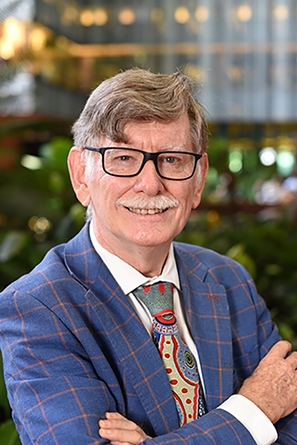
20 August 2024
Professor Graham Galloway, who championed collaborative research infrastructure and education for decades, insists that teamwork lies at the heart of his success.
“It takes many people working together to create national research platforms and programs that support them,” Professor Galloway said.
“You must establish and nurture interoperable systems that cross over institutional, and ideally, state boundaries, and connect researchers in different fields.”
In 2021, Professor Galloway became a Fellow of the International Society of Magnetic Resonance in Medicine. In 25 years of the society’s existence, 500 fellowships have been awarded worldwide, with only 5 Australians receiving this honour.
Professor Galloway is recognised for his pioneering work building national imaging research facilities and programs and his national and international leadership in MRI technology and education.
His commitment to instigating and improving research infrastructure stems from early in his research career. His first postdoctoral fellowship at Oxford University coincided with the arrival of the first whole-body magnetic resonance (MR) system capable of performing MR spectroscopy.
His research highlights involve using imaging to find innovative solutions for clinical problems. Rather than from bench-to-bedside, Professor Galloway advocates for a bedside-to-bench approach in research. A strong supporter of Health Translation Queensland, he sees a role for the network in encouraging this approach to translational research.
“We have made progress in Queensland, but we do not have a strong connection between clinical service delivery and academia yet,” Professor Galloway said.
“In other countries and some states, university research centres are embedded in hospitals. There are huge benefits for health outcomes when this happens.”
In one of his career highlights, Professor Galloway investigated fat distribution in people with type 2 diabetes. In another, he studied fat infiltration in the muscles of people with chronic whiplash. Both projects used imaging to pioneer a way forward in managing these conditions.
Professor Galloway now leads the Herston Imaging Research Facility (HIRF), a collaboration between The University of Queensland and health care sectors, where the vision is engagement with clinicians, complementing the discovery science happening on the university campuses.
He is the Director of Imaging at the Translational Research Institute, a collaborative venture striving to use exceptional science to drive better health outcomes. He was formerly the Chief Executive Officer of the National Imaging Facility from July 2017 until July 2021 after instigating NIF’s establishment and becoming its inaugural Operations Director in 2007. Under his leadership, NIF expanded, securing multimillion-dollar government funding to extend its collaborative network.
“Australia was one of the first to set up national imaging infrastructure, but European governments are more proactive in their investment and insistence on data sharing. Their capability has now overtaken ours,” Professor Galloway said.
“In Australia, we have more work to do to integrate our systems and address ethics and privacy concerns.”
Professor Galloway is passionate about providing open access to technology and the resources to use it appropriately. He is part of HTQ’s Digital Advisory Group, supporting its work to map Queensland’s digital health research ecosystem and develop the Queensland node of the Health Studies Australian National Data Asset.
He is equally passionate about education, instigating a world-first MR technology postgraduate education program, which teaches radiographers the physics and engineering of the technology they use so they can get the most out of it.
“It is rewarding to see international students who have completed the program now in senior positions overseas,” Professor Galloway said. “That tells me we’re achieving what we set out to and training tomorrow’s leaders to make informed decisions appropriate to their environment.”
While Professor Galloway is stepping away from working 70 to 80 hours a week, he remains committed to his international roles, including as co-chair of Global Bioimaging’s Expert Working Group, Chair of the Scientific Advisory Board for Matai Research Institute in New Zealand, and Scientific Advisory Board Member of Euro-BioImaging.
In the coming years, he looks forward to co-supervising students rather than leading research projects, building model trains and spending time with his 7 children and their partners worldwide.

Quicklinks
Health Translation Queensland acknowledges the Traditional Owners and their custodianship of the lands on which we live, work, and play. We pay our respects to their Ancestors and their Descendants, who continue cultural and spiritual connections to Country. We recognise their valuable contributions to Australian and global society.